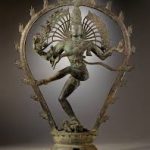Tata Vadya
- These are the chordophones or string instruments that function best when their sound is modified by hand. Stringed Instruments are of three varieties:
- Bowed: The instruments where the sound is produced by drawing a bow across the strings. For example, Sarangi, Violin, etc.
- Plectral: The instruments where strings are plucked by the fingers or by a plectrum of wire or horn. For example, Veena, Sitar, etc.
- The instruments are struck by a small hammer or pair of sticks. For example, Gotuvadyam and Swarmandal.
Sushira Vadya
- All wind instruments belong to this class.
- The most common Sushira Vadya instruments are Bansuri (Flutes), Nadaswaram (Nagaswara), Shehnai, Pungi, Sumai, Mohuri, Kama etc.
- The bamboo flute is one of the oldest Indian musical instruments. The flute in its many forms has been in use in India since the Vedic period.
- Harmonium is a wind instrument employed widely as an accompaniment to classical, light-classical, and devotional singing in Hindustani music.
- Shehnai is a double-reed wind instrument with a widening tube towards the lower end.
- It is considered auspicious and is played on all festive occasions in India.
Awanad/Avanaddha Vadya
- These are the membranophone instruments as they contain an outer membrane, which is beaten to take out particular musical sounds.
- These are also known as percussion instruments as one has to strike them to generate musical sound.
- They generally have one or two faces covered with hide or skin. The most ancient among this class are the Bhumi Dundubhi or the earth drum.
- Generally, the musical instruments included in this category are Tabla, Drum, Fhol, Congo, Mridangam, etc.
Ghana Vadya (Idiophones)
- Idiophones or Ghana Vadya are solid instruments that do not need any further tuning.
- Manjira, Jaltarang, Kanchtarang, Kasht-tarang, Khartal, Piccolo, Tic-Toc, Tong, Tasha, Kartal, Stirdrum, Kabbas, Moracus, Talam, Agogo, and Chimta are some of the Ghana Vadyas.

